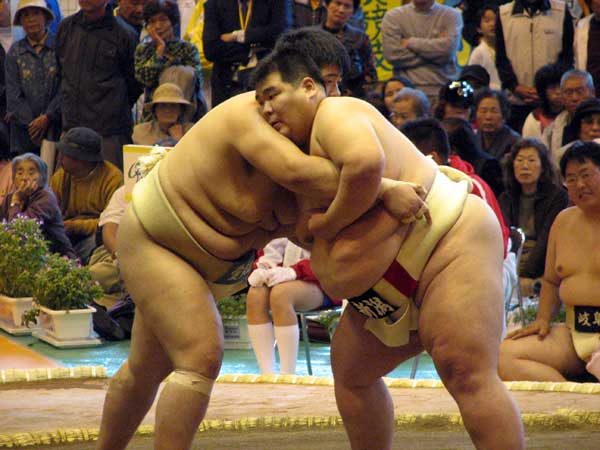
Sumo is a form of wrestling which goes back to the earliest historical
records in Japanese history.
Sumo appears in the earliest histories of Japan, the Nihon Shoki and the
Kojiki, and in early Shinto. By the end of the Heian period (794-1185), it
was established as a court ritual for some three hundred years. In the
later feudal periods, it was occasionally used as a method of resolving
political disputes by sending forth sumo wrestlers to decide the issue;
rather similar to the feudalistic European practice of using champions to
decide the right of an issue by might.

In the Edo period, sumo became a popular feature of urban culture
among the merchant class and it emerged as a professional sport with
rules and ceremonies which are closely related to today's. By the early
20th century the various governing bodies of sumo finally joined to
create a single professional organization for the sport.
In modern times, sumo has become a professional sport and is
extremely popular, arenas for sumo are plentiful throughout Japan. Since
it is native to Japan, it can perhaps better be described as the national
sport rather than baseball, the only competitor for the title.

Sumo combines some of the most public forms of Shintoritual with the
stupendous sight of wrestlers weighing up to 265 kilograms (around 580
pounds) apiece slamming into each other. At first glance, foreigners are
frequently repulsed, but continued exposure converts many into fanatics.

The rules of sumo are majestically simple: one of the two wrestlers loses
when he is forced out of the wrestling ring which measures about 15 feet
in diameter or if anything other than his feet touch the playing surface.

There are 70 ways of beating an opponent listed by the Sumo
Association, including such common ones as uwatenage (overarm throw)
and shitatenage (underarm throw), but few methods of attack are
banned. Wrestlers may trip or slap with an open hand, but eye-gouging,
hair-pulling, and hitting with a closed fist are not permitted and will result
in forfeiting the bout.
The wrestling ring is a raised clay platform with bales of straw half buried
in the clay to outline the circular ring. Wrestlers wear only a thick belt
which can be grasped by the opponent and used to lever the wearer out
of the ring.

Sumo is a very hierarchical sport. The upper division wrestlers fight
fifteen bouts in each of the six tournaments in a year. The lower divisions
fight seven matches. Promotions result from winning records and
demotions from the opposite. Each win beyond a barely winning record of
8 wins and 7 losses (or 4-3 for lower ranking wrestlers) propels a
wrestler up the rankings more quickly.

At the top of the ranks are the Grand Champions (Yokozuna) and there
may be one to four or more of them depending on the ability of the
current wrestlers. These wrestlers are usually expected to attain records
of 13-2 or better, but they are never demoted.






